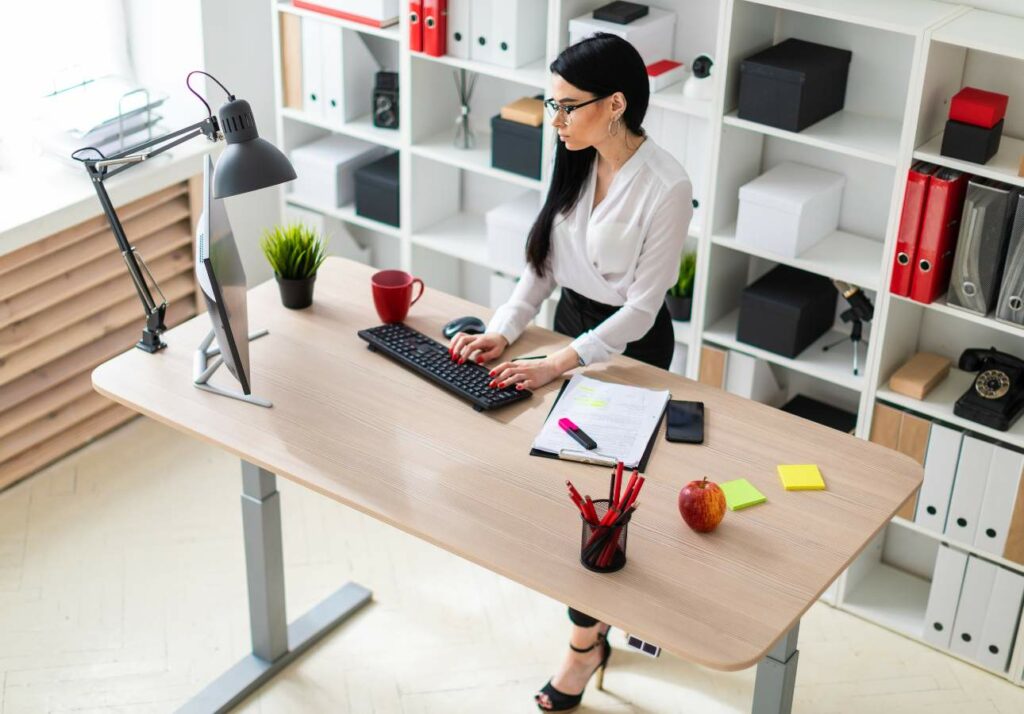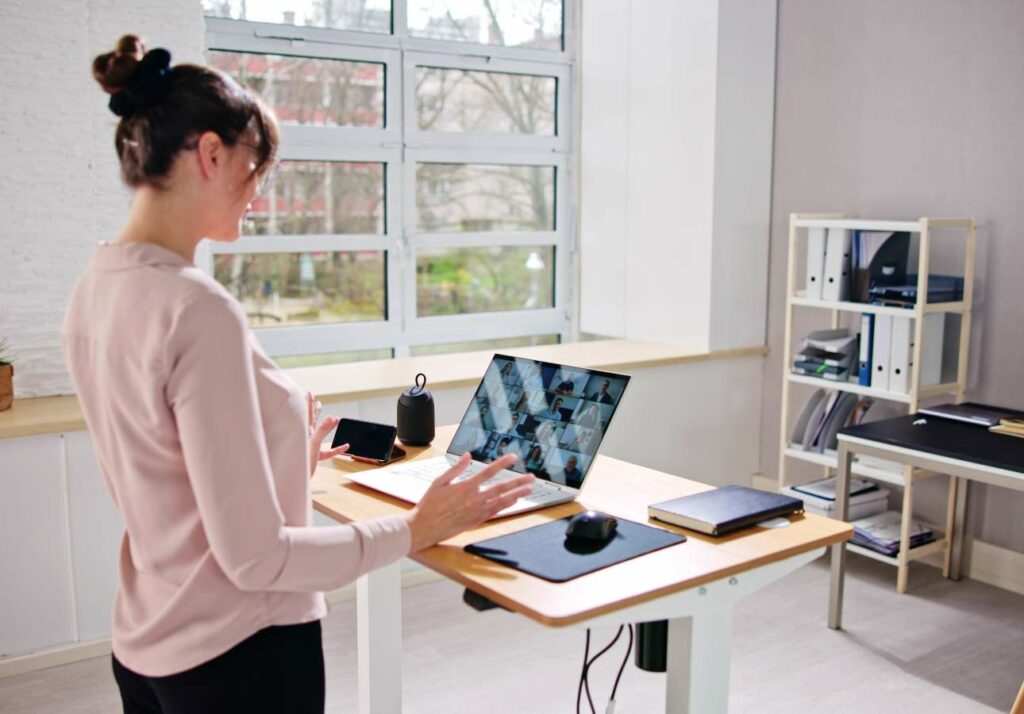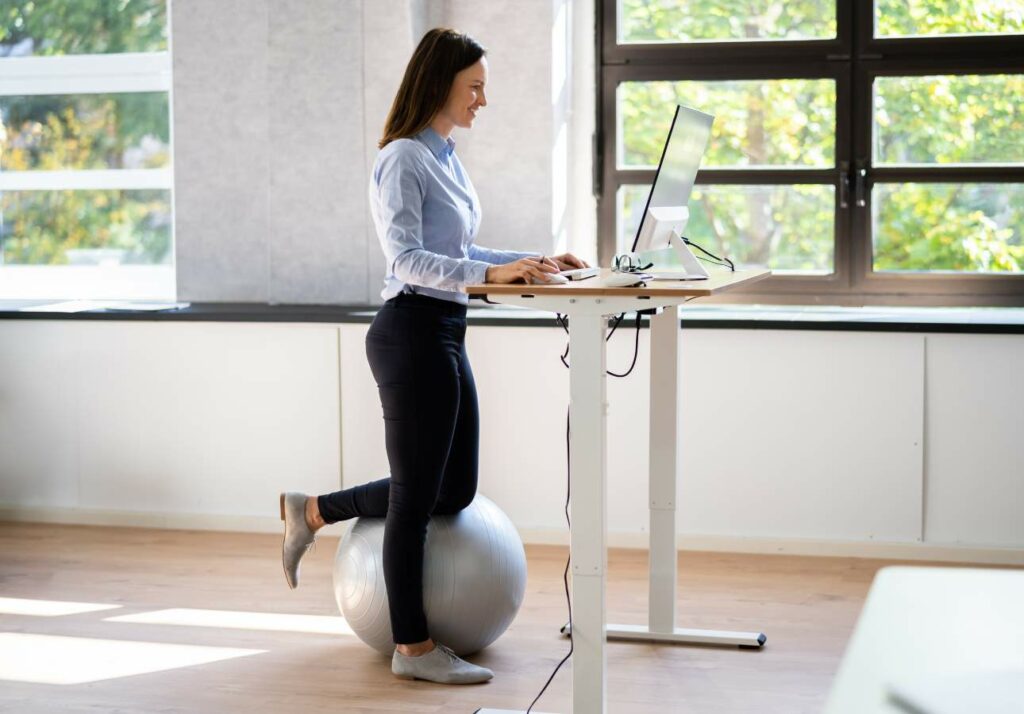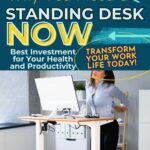Benefits of A Standing Desk
Primal Edge Health participates in the Amazon Services LLC Associates Program and other affiliate programs and therefore, may collect a share of sales or other compensation from the links on this page. This comes at no additional cost to you, and all the prices and availability are accurate at the time of publishing.
What’s the point of a standing desk? Well, if you want to improve your health and well-being, there’s a simple thing you can do: stand up. This is especially true if you have a desk job that keeps you sitting down for the better part of the day.

I work around eight hours every day, mostly while sitting down, and I’m sure many of you do, too. Before I got a standing desk or even knew how beneficial it could be, all those hours sitting down got to me. Lo and behold, I was saddled with lower back pain, which really got in the way of my productivity.
That all changed when I got a standing desk and could alternate between sitting down and standing up. So, what changes did I notice after getting one? Let’s talk about the potential benefits a standing desk can offer you, too.
Table of Contents (click to view)
Sitting at A Desk and Your Health
It seems almost contradictory. You’re working at your desk for hours, seemingly comfortable in your chair, and what happens when you finally stand up? You’re sore and stiff.
However, think back to the last road trip you took. Even if you own a high-end car, chances are that when you got out at your first stop, your body was talking back to you. That’s why it feels so good to stretch when you get up from a seated position.
It turns out that sitting — in a car or at work — isn’t good for you. According to the Mayo Clinic, when you have prolonged periods of sitting on a regular basis, you may make yourself more susceptible to unhealthy outcomes, such as:
- Increased blood pressure.
- High blood sugar.
- Excess body fat around the waist.
- Unhealthy cholesterol levels.
Creating a Standing Desk
So, how can you make a change? Create an exercise desk or walking desk, which is a combination of a standing desk and a walking pad. That’s a small treadmill without arms or a screen. Another option for a walking desk is to find a tall table with wheels that can roll over an existing treadmill like Sage Scott of Everyday Wanderer did.
“I can easily roll the table into place perpendicular to the walking surface,” she explained. “I walk at a steady 1.1 mph speed most of my work day. The only time I turn off the tread and stand still is when I’m on video calls.”
Or, you can set up a stationary, standing desk in the form of an adjustable height, freestanding table. That’s the approach Laura Sampson of Little House Big Alaska took. “My desk is adjustable. The whole thing lifts up,” she explained. “I plan to buy a treadmill that will go under it so I can also walk while I work. It will be really helpful in bad weather to get my steps in every day.”
Also, there are adjustable-height laptop stands that sit on a regular desk. When you have your computer equipment on one of these, you can raise the height of the stand so you can go from sitting to standing without interrupting your workflow.
Finally, if you’re not coordinated enough to walk or stand while you work, consider how Lara Clevenger of Lara Clevenger approached an exercise desk: she got a bike desk. Literally, a desk mounted on top of a spin bike. If you have a Peloton bike, there are even laptop trays that sit on the bike handlebars and hold a computer.
Here’s something a little unconventional: a rebounding trampoline near your working area. You can’t exactly jump while working, but rebounding is an energizing workout you can do on an off-cam meeting or while watching your favorite show.
If you’re taking a break from standing, you can try desk exercises like seated stretches or chair squats. Even if they seem insignificant, adding a little more movement to your workday can make a big difference in your posture, energy, and mood.

Ergonomics of A Standing Desk
When it comes to setting up a standing or walking desk, it isn’t just about getting out of your chair. For starters, you want to make sure you’re wearing comfortable shoes that can support your being on your feet all day. Also, you may also want to invest in an anti-fatigue mat like chefs use.
In addition, its ergonomics play a big part in setting you up for a comfortable workstation. That is, you want a computer setup that actually feels good for you, head to toe, much like a kitchen knife that is comfortable to hold and won’t leave your hands or wrist hurting.
Derrek Wiedeman, an engineer by training, is a co-creator of the StandMore desk. This desk looks more like a tripod than a workstation. It is designed to be portable, so you can take it with you if you want to move around your office or if you’re working on the road.
Wiedeman offered the following tips for setting up an ergonomically correct standing desk. It’s important to point out that these tips are based on a traditional computer setup, with a separate monitor, keyboard and mouse. If you use a laptop, you may want to invest in a monitor, wireless keyboard and Bluetooth mouse in order to achieve an optimum setup.
Monitor, Keyboard and Mouse Arrangements
When deciding at which height to have your desk, start with the monitor. Ideally, you want to be looking straight ahead and have your eye level fall somewhere between the top and the middle of the screen or monitor. This should help reduce neck issues. The monitor shouldn’t be so far away that you have to lean forward or squint to see it. At the same time it shouldn’t be so close that it causes eye strain.
Next, you want to ensure that your keyboard and mouse are positioned in such a way that you aren’t hunched over or don’t have to reach to use them. Wiedeman suggested setting the height of the keyboard and mouse surface with the following in mind:
- Your shoulders are relaxed.
- Your elbows are at a 90-degree angle.
- Your wrists are straight and can lie flat.
Finally, don’t forget about your feet. “Position your feet shoulder-width apart and parallel to each other,” Wiedeman said. “Distribute your weight evenly on both feet, avoiding excessive pressure on one foot. Consider using a footrest to support your feet and promote a more comfortable stance.”

Health Benefits of Standing to Work
Now that you know the health risks associated with sitting to work, it’s important to point out the health benefits of standing to work. According to office furniture design company Steelcase, maker of some of the first standing desks for offices, a long-term survey of employees using standing workspaces found the following positive effects:
- Nearly half reported a significant reduction in upper back, shoulder or neck discomfort.
- Two-thirds reported increased productivity after one year.
- Two-thirds said height-adjustable desks positively impacted their health outside of the workplace.
Those surveyed also reported feeling that they could concentrate better at work. And, overall, they said they were more active, refreshed, awake, limber and energetic. Here are other lesser known benefits that you might get from getting a standing desk.
Better Sleep
A 2022 study by Frontiers of Immunology showed that sedentary behavior can significantly lead to sleep disturbances, and exercise is a great way to prevent that. While standing isn’t exactly exercise, you tend to move more while standing up compared to sitting down. Plus, you can do mini desk exercises while standing or put a walking pad under your desk to increase your daily movement.
Any effort to move around more during the day can help you improve your circadian rhythm, which regulates your natural sleep-wake cycle. You’ll likely find it easier to fall asleep because you’re more tired, and standing can help prevent body pain that can keep you from sleeping comfortably.
Increased Productivity
Simply standing up can make you feel more awake and alert, which is a great alternative to coffee. Switching from a sitting to a standing position can help get your blood flowing which, in turn, gives your brain more oxygen.
As a result, you’re more focused, efficient, and, ultimately, more productive. So, instead of reaching for another cup of coffee during those sleepy afternoon hours, switch your desk to standing mode. Can’t resist? Try these low-caffeine coffees instead of your regular brew.
Improved Mental Health
It might sound a bit outlandish, but the simple act of standing up can have significant mental health benefits. According to this 2020 study on the effects of sit-stand desks on mental health during the pandemic, standing up can help reduce the likelihood of a completely sedentary lifestyle.
More specifically, your heart rate goes up, your brain receives more oxygen, and you expend more energy—all benchmarks of what you might consider traditional exercise. In most people, these effects can help relieve anxiety, depression, and even work-related boredom, leading to better moods.
FAQs
Yes. For starters, you can easily adjust the height of the desk to be ergonomic for your height and posture. Plus, some standing desk stores let you customize your tabletop sizes in case you need to put more equipment on your desk or simply prefer a bigger workspace.
The best ratio is 1:1 or 30 minutes for every hour. Set a reminder so you can stand up and sit down on “schedule.” If 30 minutes is too long, start with 5 to 15 minutes every hour.
The more comfortable the shoes, the better. They should be comfy enough that you don’t feel that much strain while standing. You can also go barefoot if you’re working at home, but make sure to use an anti-fatigue mat to relieve the pressure from your feet.
Final Thoughts
Who wouldn’t want to feel more refreshed and energetic after working all day? Hopefully, these outcomes convince you that by using a standing, walking or exercise desk, you can practice self-care and still be productive in your job.
Portions of this article originally appeared on Food Drink Life.








Wow! This is a big help, especially for those working from home who find it hard to stay focused and not get sleepy while working
I feel you, Samantha. Using a standing desk has helped a lot with my productivity. I highly recommend!
Wow! I think I should find a table like this! It would be really useful, especially for those working from home.
Hello, Anabelle! I hope you find an option that you’ll like. Rooting for you!